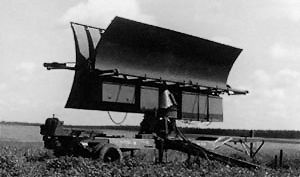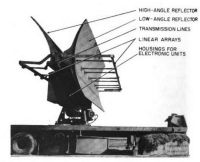AN/CPS-1
Description of the radar set, tactical-technical characteristics

Figure 1: AN/CPS-1
 Hersteller:
Hersteller:MIT's Radiation Laboratory
| Specifications | |
|---|---|
| frequency: | 3 200 MHz (S-Band) |
| pulse repetition time (PRT): | |
| pulse repetition frequency (PRF): | |
| pulsewidth (τ): | |
| receive time: | |
| dead time: | |
| peak power: | (700 kW ? ) |
| average power: | |
| instrumented range: | 200 miles (≙ 322 km) |
| range resolution: | |
| accuracy: | |
| beamwidth: | 0.8° |
| hits per scan: | |
| antenna rotation: | 10 rpm |
| MTBCF: | |
| MTTR: | |
AN/CPS-1
AN/CPS-1 alias Microwave Early Warning (MEW) radar, was built at the end of the Second World War and operated in S-Band. This frequency band removed two serious problems of meter-wave air-warning sets: their poor angular resolution of targets and their blindness for low-flying aircraft. In providing excellent 0.8° horizontal location it relinquished any knowledge of height, which proved to be no disadvantage in guiding fighters and alerting gun crews against the uniformly low-flying V-1 flying bombs. A very narrow vertical fan-shaped beam was attained through a linear array of 106 slots cut into a waveguide across the focal line of a cylindrical parabolic reflector. A refector that would secure good low-level coverage at long-ranges would not form a beam tall enough vertically for near-in targets that were high, so there was a second antenna for high coverage, the two mounted back to back. Each reflector was 7.6 meters (25 feet) wide. The low-coverage reflector was 2.4 meters (7 feet 10 inches) tall, while the high-coverage reflector was 1.5 meters (4 feet 11 inches) tall. The MEW control electronics included five 30-centimeter (1-foot) scope displays, allowing operators to track large numbers of targets.
Only six handcrafted sets were made. Set number one operated in Britain January 1944.

